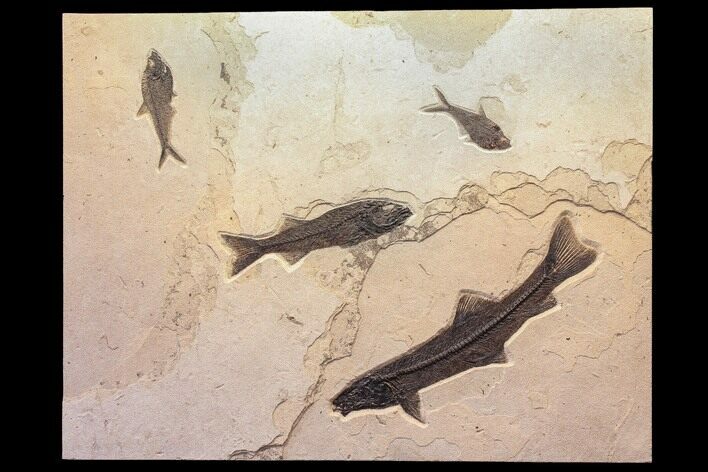This Specimen has been sold.
42" Wide Green River Fossil Fish "Mural" - Authentic Fossils
Due to the size and weight of this piece it will be shipped on a pallet or in a crate via freight. Our website cannot automatically calculate freight shipping costs, so these costs will be calculated and billed after purchase. Please contact us prior to purchase if you need a shipping quote.
This is a spectacular fossil fish "mural" from the Green River Formation of Wyoming. It measures 42 x 20" and four large fossil fish of three different species. The largest specimen on the slab is a 20" Notogoneus osculus a fairly rare fish in the formation. There is also a Mioplosus labracoides and a pair of Diplomystus dentatus
Several of the fossils have been inlaid into the rock for display purposes. The large slab of rock has been backed with wood for stability is ready to be hung on a wall.
About The 18 Inch Layer Of Fossil Lake
Specimens like this come from the coveted 18 inch layer of the Green River Formation, which produces darker and more detailed fish than the majority on the market. The rock from this layer is much harder and more durable than other layers in the formation, likely due to its initial deposition conditions in deep water. Because of these conditions, fish found in the 18-inch layer can be extracted whole and in excellent condition. This layer is typically collected at night using low-angle light to see the bump in the rock that the fish's backbone creates. They then cut these fish out and take them to a lab where the fish, which may be up to an inch under the surface of the rock, are meticulously extracted under microscope with hand tools.
Specimens like this come from the coveted 18 inch layer of the Green River Formation, which produces darker and more detailed fish than the majority on the market. The rock from this layer is much harder and more durable than other layers in the formation, likely due to its initial deposition conditions in deep water. Because of these conditions, fish found in the 18-inch layer can be extracted whole and in excellent condition. This layer is typically collected at night using low-angle light to see the bump in the rock that the fish's backbone creates. They then cut these fish out and take them to a lab where the fish, which may be up to an inch under the surface of the rock, are meticulously extracted under microscope with hand tools.
SPECIES
Notogoneus osculus, Mioplosus labracoides & Diplomystus dentatus
LOCATION
Kemmerer, Wyoming
FORMATION
Green River Formation - 18 Inch Layer
SIZE
42 x 32", largest fish about 20", about 200 lbs
CATEGORY
SUB CATEGORY
ITEM
#132127
We guarantee the authenticity of all of our specimens.
 Reviews
Reviews














